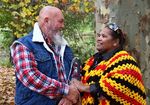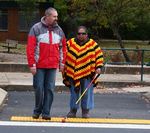Aunty Mary's Story Vision Loss and Transition Planning A guide to vision loss
←
→
Page content transcription
If your browser does not render page correctly, please read the page content below
Vision Loss and Transition Planning
A guide to vision loss
Aunty
Mary’s
Story
Mary.
Produced in consultation with AuntyAunty Mary’s Story
I’m Aunty Mary, and I’m a Bundjalong
woman. I’m one of 12; eight in my family have
diabetes. I am the only one who has vision
loss from diabetes.
My eyesight changed from day to day, but
when I lost my sight I was terrified of going
outside. After listening to an ad on TV about
Guide Dogs – that they offered cane training -
Understanding
not just dogs, I contacted them.
Vision Loss
An instructor from Guide Dogs NSW/ACT
Vision loss happens for different
came to my home to show me how to use a
reasons, and this affects how people
long cane. They taught me how to get to the
see. Some people get blurred or
shops, cross the road safely and move around
patchy vision. Others have problems
my community on my own. They were able to
with their central or side vision.
help my family too.
Glasses don’t always help.
I wouldn’t have gained my confidence without
A person’s vision can change daily
the free training and support from Guide Dogs
depending on lighting, weather
NSW/ACT.
conditions and their general health.
I have my cane in Aboriginal colours – it
Often you can’t always tell if a person
makes me feel proud.
has trouble seeing. People with Guide
Call Guide Dogs. Once you make that initial phone Dogs and canes may have some
call, it will be the best call you will ever make. limited but useful vision.
2Vision conditions
Aboriginal and Torres Strait
Islander communities are
six times more likely to get
vision problems.*
Diabetic Retinopathy is caused by Diabetes. The
veins at the back of the eye can become damaged.
Good control of diabetes and regular eye checks
are important.
Cataracts are generally related to ageing and sun
but can often be safely treated.
Glaucoma is caused by increased pressure in the
eye. Often there are no symptoms.
Macular Degeneration is related to ageing. Risk
factors include smoking and poor diet.
Vision loss caused by stroke or brain injury.
Have your eyes checked regularly, as often there
are no symptoms to indicate your vision may be
changing. However, if you are losing some sight,
help is at hand.
*National Indigenous Eye Health Survey, 2009, published by the Indigenous Eye Health Unit, Melbourne School of Population Health, The 3
University of Melbourne in collaboration with the Centre for Eye Research Australia and the Vision CRC.Practical tips to help people with vision loss
Guiding
Guiding is an easy way to help a person
move about safely. The person will
usually take your arm and follow you.
Here are some basic tips:
• Ask the person if they need assistance.
• Make contact using the back of your hand or forearm
so they know where your arm is located.
• They will usually hold your arm just above your elbow.
• Walk in front, at a comfortable pace and avoid hazards.
Modified Techniques - some people might have their preferred way of
being guided. It’s always best to do what they feel most comfortable with.
Mobility canes come in different sizes and colours.
4Narrow space or doorway -Slow down
and move your guiding arm behind
your back so you can walk in single file
through the door.
When going through a door, tell the
person which way the door opens.
Chair - Tell them what kind of chair it is
and which way it is facing. Place your
guiding hand on the back of the chair.
The person will be able to find the chair
and sit down.
Stairs/gutters - Tell the person which
way the stairs are going – up or down.
Check if the person would like to use
the handrail and if they need help to find
where it is. Walk one step ahead. Tell
them when they’ve reached the top or
bottom of the stairs.
Cars - When you approach a car, tell
the person which way the car is facing.
Open the door and place your guiding
hand on top of the door. When they are
seated, let the person know when you
are about to close the door.
5Practical tips to help people with vision loss
Giving Directions
When offering help:
• Always introduce yourself
• Ask the person if they need assistance
• Ask how you can help
When giving directions, be clear and remember: Left means their left, not yours.
Directions like, “It’s just over there” isn’t enough for those who are blind. Try the
“clock-face” technique.
Every day activities like going to a café can be made easier with some simple
assistance. Some people may be able to read the menu whilst others may not.
If you’re not sure, just ask.
CLOCK-FACE
technique
This is a simple way to
describe the location
6Recognising a Guide Dog
A Guide Dog is not a pet; it’s helping
the person to move around safely and
independently.
When a Guide Dog is in harness, it
means it’s working and you shouldn’t
pat, feed or distract it in any way.
People using a Guide Dog in harness
can legally enter all public places
including restaurants, pubs, clubs,
cafes and shops as well as taxis, public
transport and hospitals.
7Guide Dogs NSW/ACT provides help to
people with different levels of vision loss
from all walks of life and age groups. We
offer a range of services and we’ll come to
you. All our orientation and mobility services
including Guide Dogs are completely free to
anyone who needs them.
“Without Guide Dogs I wouldn’t know what to do. They
are my backbone. Ring Guide Dogs, they’ll help you too.”
Rodney Hooker, Aunty Mary’s husband
If you need help call Guide Dogs on 1800 804 805 or
contact your nearest office:
Albury 6041 5201 Newcastle 4925 3066
Blacktown 9676 5802 Orange 6362 6625
Chatswood 9412 9300 Tamworth 6761 3152
Coffs Harbour 6652 7424 Wagga Wagga 6925 3559
Deakin (ACT) 6285 2988 Wollongong 4225 9247
Lismore 6621 8475
www.guidedogs.com.au
GDN0205 1 23/08/2013You can also read



























































